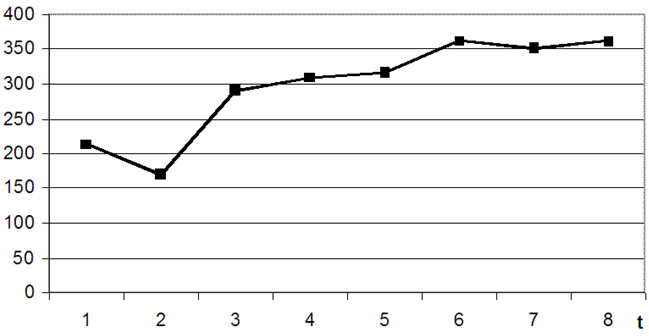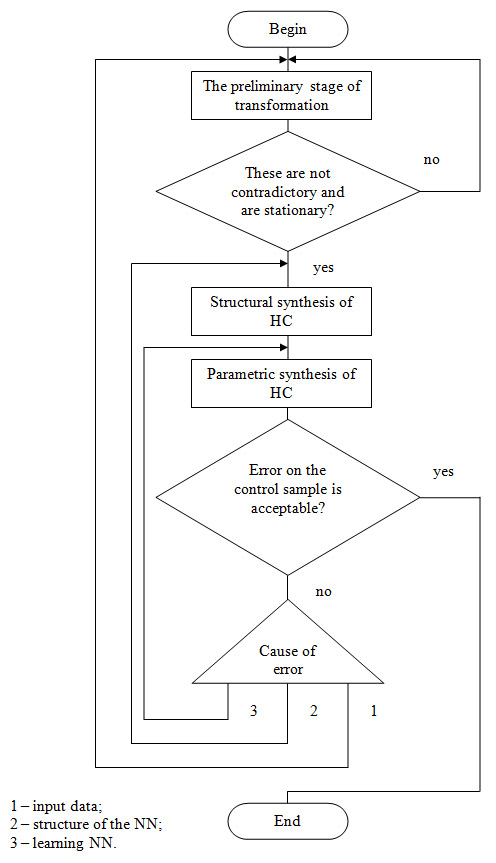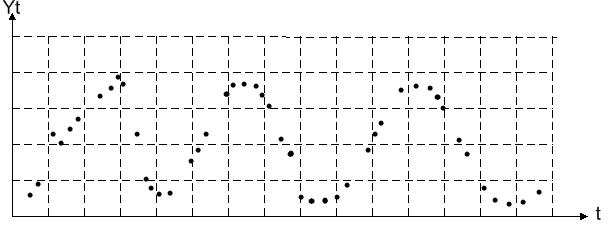Abstract
Содержание
- Introduction
- 1. The goal and tasks of research
- 2. The actuality of the topic
- 3. Scientific novelty
- 4. General information about the time series
- 5. Pre-conversion time series in the tasks of forecasting
- Conclusions
- Reference list
Introduction
Time series are of great importance for the detection and study of emerging patterns in the development of the phenomena of economic, political and cultural life of society. With their help is solved relevant to the present-day problem of forecasting.
Implementation of the transformation of the time series in the training set – current and byway. These transformations are directly dependent on the characteristics of the time series.
The purpose of master's work is the development of segmentation algorithm time series and software implementation of the developed method.
1. The goal and tasks of research
The aim of this study is to analyze the current state of scientific research in the field of statistics and forecasting for the subsequent development of the segmentation algorithm of time series.
The main task is to formulate the basic requirements to the transformations of the time-series, necessary to reduce the error methods of forecasting. In the work of the master planned development and program realization of algorithm of formation of learning sample of the time series for forecasting of time series in the tasks of forecasting.
Object of research is the time series.
The subject of the study are preliminary transformation of the time series in the tasks of forecasting.
2. The actuality of the topic
One of the topical problems of today there are task of forecasting. The quality of the forecast, often, depends on many things. At the moment there is a huge amount of forecasting algorithms, the result of which directly depends on input data, i.e. samples, formed from a time series.
One of the most important stages of the problem solution of neural network forecasting is the formation of a learning sample. Many of the prediction algorithms give good results provided enough of a small quantity of the input data. If the number of values in the time series is very large, it should be reduced in a way that would display all of its properties in the fully – make the selection or the segmentation of the time series without loss of “meaning” [1].
3. Scientific novelty
Scientific novelty of this work is to develop a time series segmentation algorithm – a new direction in the pre-processing of time series and the formation of a large amount on the basis of their training samples, effective problem-solving pre-processing of data in forecasting problems.
4. General information about the time series
Time series is a series of observations for the values of some indicators (signs), arranged in chronological order, i.e. ascending t-temporary variable parameter [2, 3].
Thus, the time series is a series arranged in a chronological sequence of numeric values of statistical indicators that characterize the changing social phenomena over time. Time series are usually present in the form of a table or graph. For example, Table 1 presents data reflecting the demand for a certain product for an 8-year period, i.e. the time series of the demand Yt.
Table 4.1 – Data demand for a certain product for an 8-year period
| Year t | 1 | 2 | 3 | 4 | 5 | 6 | 7 | 8 |
| Demand Yt | 213 | 171 | 291 | 309 | 317 | 362 | 351 | 361 |
The time series can be represented graphically (figure 4.1).

Figure 4.1 – Graphical representation of the time series
5. Pre-conversion time series in the tasks of forecasting
Prediction Method – a way to create a prediction through practical and theoretical activities. There are many methods of forecasting. Standard Classification of forecasting methods do not exist [4].
Forecasting Time Series – calculating the value of its future values or characteristics which allow to determine this value, based on an analysis of known values. The value to be predicted is called the predicted value (PV) [4, 5].
Problem-solving scheme prediction can be represented as a sequence of stages (figure 5.1).

Figure 5.1 – Scheme of solving the problem of forecasting
Pre-conversion (PC) – getting to the moment of time ti of a set of determining factors and corresponding values of the supply air. After the PC for different moments of time t, the time series presented in the form of a set of values of the function depending on the determining factors. Out of the numerous sets can be divided into two disjoint subsets. One of them represents the raw data (the training sample). Another subset of is a test sample is used for testing the quality of forecasts [6].
Certain complexity is the formation of training sample, which must fulfill the requirements for completeness and consistency [7].
Obviously, increasing the number of input variables increases the error [8] (figure 5.2).

Figure 5.2 – Prediction of the time series after a preliminary transformation
(animation: 5 frames, 7 cycles of recurrence, 36 KB)
So, it is necessary to develop an algorithm that will allow a sample of the time series so that the loss of accuracy is within acceptable limits, and reducing the number of values does not entail an increase in the error prediction algorithm. Therefore, the input will be a time series output - sampling, which later will be the input data for forecasting algorithms.
This algorithm must satisfy the following requirements:
- — the ability to recover future values of TS with the required accuracy;
- — to describe the situation fewer symptoms without loss or with acceptable loss of accuracy;
- — eliminating redundancy;
- — to ensure stationarity of the series features;
- — to ensure the consistency of a number of features.
To date been developed algorithm of forecasting of time series. But neglected preliminary transformations, such as the formation of the learning sample, which can reduce the error of the forecast [9-11].
Conclusions
Consideration was given to the actual problem of formation training set of time series for time series prediction problems in neural network forecasting. The issues of preliminary data transformation tasks in time series prediction by a neural network.
Were established requirements for the algorithm that will be developed in the final work of the master.
The analysis shows that the new algorithm will provide a reduction in training time of the neural network or influence the outcome of solving the problem of forecasting, as result of the algorithm - is the source data for the task of forecasting.
Reference list
- Тарасенко Р.А. Предварительная оценка качества обучающей выборки для нейронных сетей в задачах прогнозирования временных рядов / Р.А. Тарасенко, В.А. Крисилов, // Труды Одесского политехнического университета – Одесса – 2001. – №1. – С. 90.
- Гусаров В.М. Статистика: Учебное пособие для вузов / В.М. Гусаров. – М. : ЮНИТИ – ДАНА, 2001.
- Новиков М.М. Статистика. Показатели и методы анализа: Учебное пособие / М.М. Новиков. – М. : Современная школа, 2005.
- Бокс Дж. Анализ временных рядов. Прогноз и управление / Дж. Бокс, Г. Дженкинс М. : Мир, 1974.
- Афанасьев В.Н. Анализ временных рядов и прогнозирование: Учебник / В.Н. Афанасьев, М.М. Юзбашев. – М.: Финансы и статистика, 2001.
- Крисилов В.А. Представление исходных данных в задачах нейросетевого прогнозирования / В.А. Крисилов, К.В. Чумичкин, А.В. Кондратюк // Научная сессия мифи – 2003. – М.: МИФИ, 2003. – С 184–191.
- Востров Н.Г. Моделирование временных рядов с использованием вейвлет-сетей / Н.Г. Востров, В.В. Любченко, М.В. Полякова // Искусственный интеллект. – Донецк – 2000. – №3. – С 207–214.
- Technologic by newwpthemes [Электронный ресурс]. – Режим доступа: http://nejroseti.ru/category/predstavlenie-ishodnyh-dannyh-v-zadachah/page/2/.
- Тарасенко Р.А. Метод анализа и повышения качества обучающих выборок нейронных сетей для прогнозирования временных рядов. / Р.А. Тарасенко – ОНПУ, 2001.
- Козадаев А.С. Прогнозирование временных рядов с помощью аппарата искусственных нейронных сетей. Краткосрочный прогноз температуры воздуха / А.С. Козадаев, А.А. Арзамасцев. – Естественные и технические науки, 2006.
- Зайцев П.Н. Нечеткая сегментация временных рядов / П.Н. Зайцев // Вестник ВГУ – Воронеж – 2009. – №1. – С 60–67.
